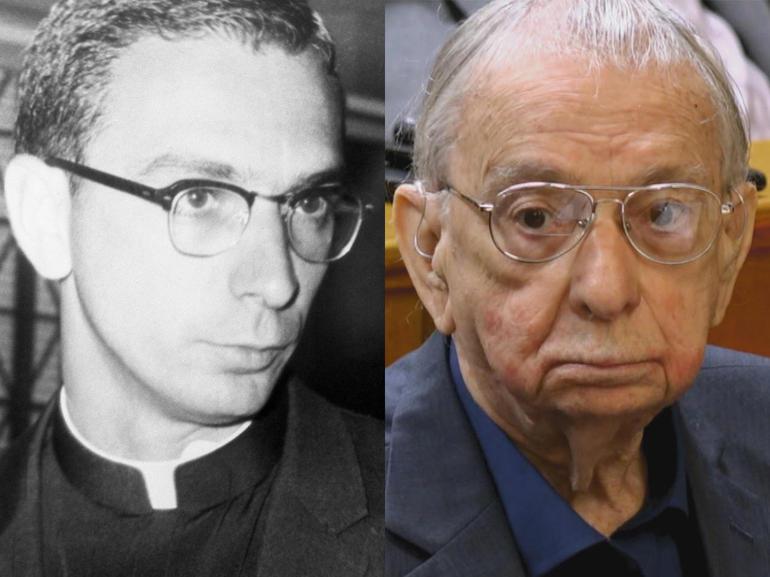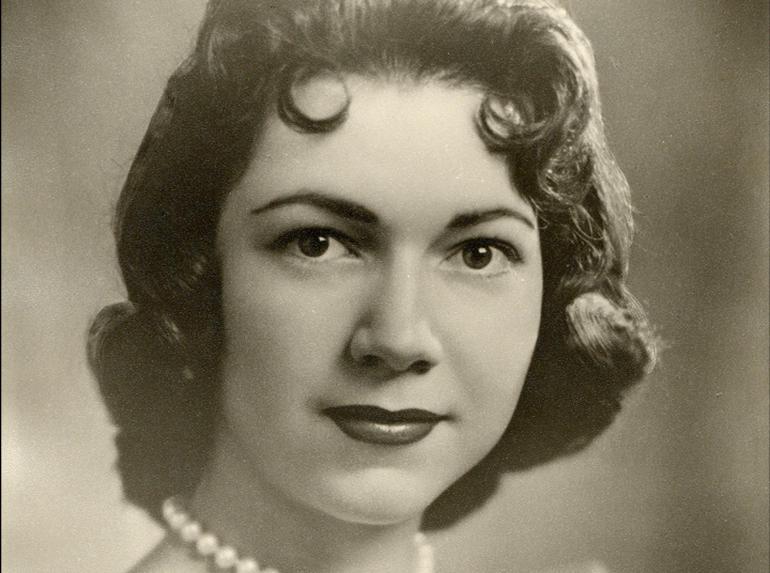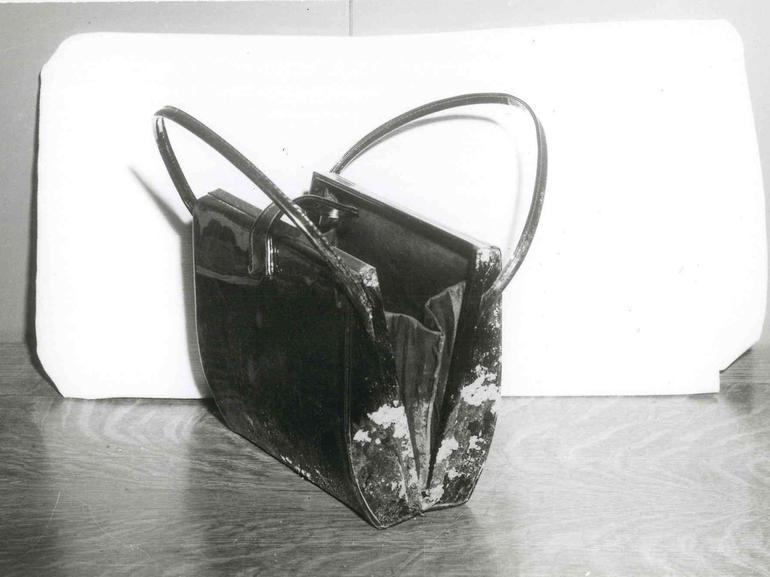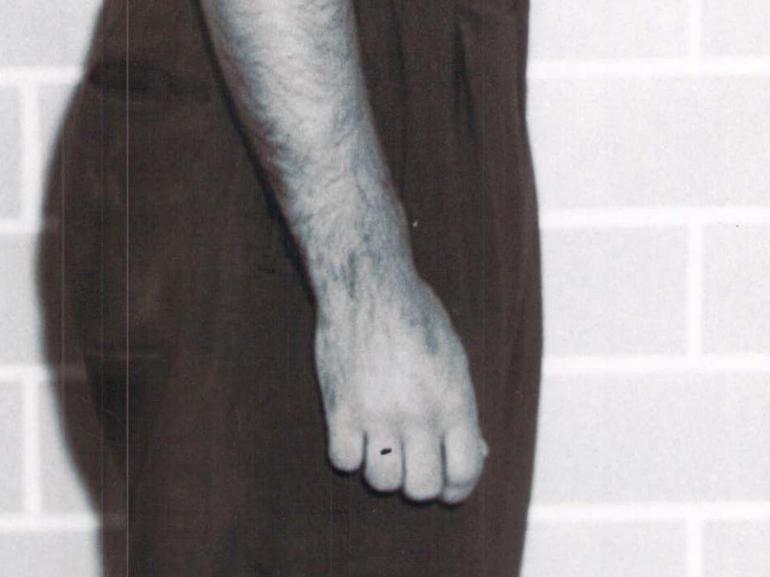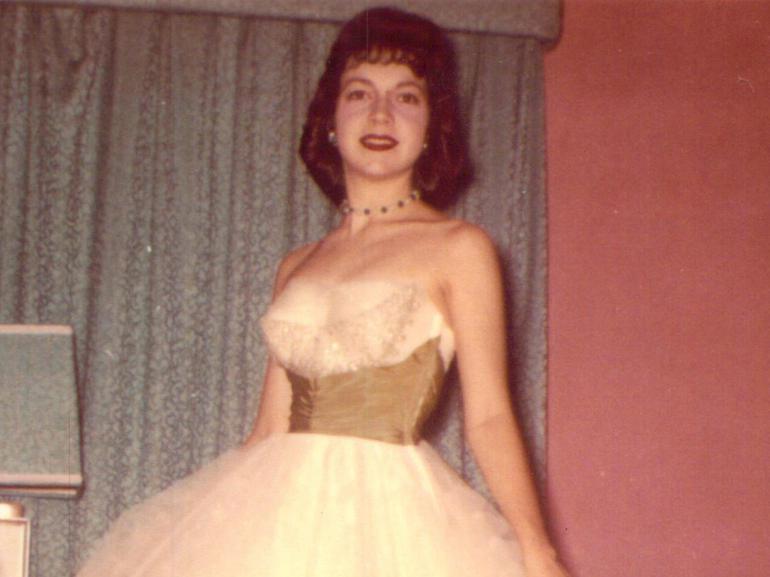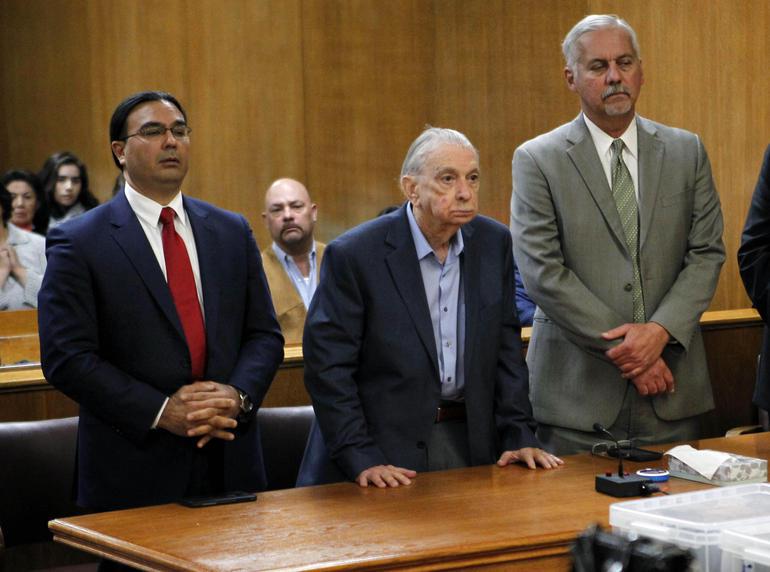|
Inside the Trial of Former Priest Charged with 1960 Murder of Texas Schoolteacher
By Lourdes Aguiar, Josh Gaynor And Ruth Chenetz
[with video] After 57 years, a former priest is on trial for murdering a young woman who had gone to him for confession -- did the church conspire with authorities to cover it up? It was April 1960 in McAllen, Texas, when Irene Garza, 25, told her family she was going to church for confession. She never returned. Five days later, her body was found dumped in a canal. Police say she was beaten, sexually assaulted and suffocated. Investigators kept turning to one person – Father John Feit, then 27, who admitted hearing Garza's last confession in the church rectory. Investigators grew more suspicious when they learned that three weeks before Irene's murder, another young woman had been attacked in a nearby church. That woman later identified Feit as her attacker. Feit would eventually plead no contest to aggravated assault in that case and was fined $500, but the investigation in the Irene Garza murder eventually stopped and the case went cold. For decades, rumors swirled that there had been a conspiracy between the authorities and the Church to cover up the crime. The case was reopened in 2002 when the McAllen Police Department asked the Texas Rangers' cold case unit to re-examine the murder. The investigation took a turn when a former monk, Dale Tacheny, told police that back in 1963 when he was counseling novice monks at a monastery, Feit had admitted to killing a young woman on Easter weekend. Another priest also came forward saying Feit had made a similar admission to him as well. Yet the former district attorney at the time, Rene Guerra, didn't find the new witnesses credible and the case would go nowhere. Irene Garza's family felt they had been denied justice again. In 2014, when confronted by "48Hours" about the allegations, Feit told "48 Hours" correspondent Richard Schlesinger he didn't kill Garza and did not know who did. Shortly after "The Last Confession" --"48 Hours"' first broadcast on the case -- aired 2014, a new district attorney was elected who promised to look into the case. On Feb. 9, 2016, Feit was arrested in Scottsdale, Ariz. and charged with murder. Feit's attorney, Rene Flores, maintains there are no witnesses, no DNA evidence and no forensic evidence that ties his client to the murder of Irene Garza. He says there was never any conspiracy, just a lack of evidence in the case, and that's why Feit was not prosecuted. "There may be people who don't understand why an old man is being prosecuted," says Mike Garza. "But make no mistake. This is an evil man. He was a predator. He's a wolf in priest's clothing -- looking to attack." THE MURDER OF IRENE GARZAHidalgo County Assistant District Attorney Mike Garza is not part of Irene Garza's family, but Irene Garza's story has been part of almost everyone's life in McAllen, Texas, for generations. Prosecutor Mike Garza: It kind of grew to folklore, kinda grew of legend about a girl that you know went to confession and you know never left. The story of the priest accused of killing a parishioner is finally being heard in a courtroom after nearly 60 years. Richard Schlesinger | "48 Hours" correspondent: Does your Catholicism make it more difficult for you to go after this guy? Mike Garza: The church seeks to do good. It's the men in the church and the men at that time that did wrong.
He's 85 years old now, and former priest John Feit hardly looks like the heartless killer the State says he was in 1960. It was a rainy Easter Sunday. Sylvia Acevedo Stern was then 18 when she received some news about her childhood friend Irene Garza that she has difficulty talking about … still. Sylvia Acevedo Stern [in court]: We were all very scared. [Crying] It was just the scary unknown that someone you knew and that you loved had disappeared. Irene Garza, 25, had gone to confession at Sacred Heart Church the night before and had failed to return to her parent's home where she still lived. Sylvia Acevedo Stern: That was not like Irene. She checked in all the time. Parishioners had spotted Irene earlier that night -- putting on a lace veil, kneeling in a pew and in a confession line -- but no one ever said they saw her leaving the church grounds. Mike Garza: People remembered her, whether she was your neighbor, whether your wife was jealous of her. People knew her. Irene had been crowned prom and homecoming queen at the local college and Miss All South Texas Sweetheart. Noemi Ponce Sigler was part of Irene's extended family. Richard Schlesinger: Do you remember how you felt about her? What she meant to you? Noemi Ponce Sigler: She stood out, she was elegant. But Irene was far more than just a pretty face; she was a trailblazer, says her cousin Lynda de la Viña. Lynda de la Viña: She and her sister Josie were the first Mexican-American twirlers in the history of McAllen High School. And then, ultimately, she became the drum majorette -- the first Mexican-American drum majorette. Irene had been the first in her family to go to college and graduate school. She became a second-grade teacher and chose to work with McAllen's poorest students. Lynda de la Viña: Oftentimes she would use part of her salary to buy them school supplies, to buy them the things that they needed. And Irene was generous with her own family. De la Viña was just 9, but she still remembers their last conversation. Lynda de la Viña: She had Easter baskets for us. And my brother and I were excited and jumping up and down, 'cause we just knew that she would not have forgotten us. But before Easter Sunday, Irene had to go to confession at Sacred Heart Church. Religion played a central role in her life. Richard Schlesinger: Every Sunday she'd go to church? Lynda de la Viña: Every Sunday. Every Saturday she'd go to confession [laughs]. … It was a little bit of a family thing: "Irene's going to confession whether she needs it or not." When she disappeared, the search for Irene Garza was huge. Seventy members of the Hidalgo Sheriff's Posse -- many on horseback -- fanned out looking for Irene. And one of them was Sigler's father. Noemi Ponce Sigler: That man wouldn't even sleep trying to find Irene. Sylvia Acevedo Stern remained at the Garza home for days after Irene vanished. She says at first, everyone tried to hold onto hope. But then Irene's purse was found near a dirt road.
The news only got worse. Just up the road, they found Irene's shoe.
Sylvia Acevedo Stern [to Schlesinger]: And the shoe was -- it was a killer. Then, five days after she vanished, everyone's worst fear was confirmed when Irene's body was found floating in an irrigation canal. Sylvia Acevedo Stern: And I just remember her mother just dissolving. …I just saw her just bending over in pain. Irene was still partially dressed, but her blouse was unbuttoned and her underwear was missing. The autopsy showed she had been beaten and sexually assaulted. Mike Garza: It would show that she was killed by asphyxiation, probably suffocation. At first, there were few leads at the crime scene. There was an imprint of Irene's petticoat found on the banks of the canal and a partial heel print from a man's shoe. But, two weeks later, police discovered a curious clue. They drained the canal and on the bottom they found a photo slide viewer. The police turned to the public for help in identifying the owner. Two days later, they received a note from Father John Feit, a visiting priest from the Missionary Oblates of Mary Immaculate. Mike Garza: John Feit writes a letter saying "that slide viewer belongs to me." Richard Schlesinger: Why in the world would he tell the police, "Yeah. That's my slide viewer?" Mike Garza: I think it was taunting. Richard Schlesinger: Taunting the police? Mike Garza: Taunting the police. Police only grew more suspicious of the 27-year-old priest when he gave them different stories about that night. At first he said he had not heard her confession at all. Mike Garza: He changes it by saying later… "I took her confession in the rectory." And there were other peculiarities. Feit had been staying temporarily at the rectory to help with the busy Easter holiday, but he kept going back to the Pastoral House where he lived just a few miles away. Mike Garza: Six times in a 24-hour period. …He used excuses like breaking his glasses, needing to get clean clothes, different things that became very suspicious. And Father Joseph O'Brien, the assistant pastor, told police that Feit had some injuries the night Irene disappeared. Mike Garza: He noticed some scratches on his hands … scratches that ran vertically down his hands on the tops of his arms. Father Feit said he had been locked out of the Pastoral House and had scratched his hands climbing up to the second floor balcony. Mike Garza: They were on the backs of his hands, so I guess this gentleman climbs a wall like this [motions with his hands] but he said he got them climbing a wall. Richard Schlesinger: They had a pretty good case against him. …Why wasn't he arrested? Mike Garza: He was protected -- Richard Schlesinger: By? Mike Garza: -- by the hierarchy of the Catholic church. WAS THERE A COVER-UP?In the days after Irene Garza's murder, Sylvia Acevedo Stern was struggling not just with grief, but also with guilt. On the Saturday she vanished, Irene called Sylvia's house hoping she could accompany her to confession. But Sylvia wasn't home. Sylvia Acevedo Stern: It's always been very difficult …That day might have different because if I had been with her…she might not have gone to the rectory. But why had Irene agreed to go to the rectory that night? A new witness, Ana Maria Hollingsworth, testified that Father Feit had pulled Irene out of the confessional before.
Mike Garza: He pulled her out of the confessional, told her she was too good to confess in the confessional and took her to the rectory. Hollingsworth says her friend Irene seemed confused by Feit's insistence. Richard Schlesinger: If that's true, why would she have gone with him to the rectory on that Saturday evening? Mike Garza: Because he was a priest and you didn't fear priests back then. She had no reason to suspect he was gonna do something violent or sexual to her. What angers Mike Garza is that he says the Church had warning signs about Feit. Just three weeks before Irene was killed, a woman named Maria America Guerra had been attacked in a nearby church. Mike Garza: A man that she had seen … came up behind her … tried to stuff a rag in her mouth, threw her to the ground. And at that point, she was able to bite his finger so hard that she tasted blood in her mouth … and get away. Although the Church suspected Feit, he was not turned in. Mike Garza says a source told him the solution was to send Feit a few miles away, to Irene's family parish. Richard Schlesinger: What was the point of that? Mike Garza: I guess to keep an eye on him. I guess, to protect him at the time. They certainly -- Richard Schlesinger: Protect him? Mike Garza: To protect him. Richard Schlesinger: So did he behave himself up until the time that you believe he killed Irene Garza? Mike Garza: No. Garza found another new witness, Beatrice Garcia, who says in the weeks before Irene Garza was murdered, she had a bizarre encounter with Father Feit.
Mike Garza: And that man in the car. Who was it? Beatrice Garcia: He was the priest. That's him right there [points to a photo of Father Feit on a monitor]. Mike Garza: He liked a certain look in a woman. …America Guerra, Beatrice Garcia, Irene Garza -- they all look the same. America Guerra was a violent attack and maybe he got a little taste for it then and was looking for his next victim. And Garza says that victim ended up being Irene. Yet despite the evidence against Feit at the time, the case seemed to stall. Noemi Ponce Sigler recalls finding her father -- one of the original investigators -- very upset one day. Noemi Ponce Sigler: I saw him sittin' in a chair with a white handkerchief, and he was crying. Sigler says her father had been told his superiors would take over the investigation. Around that time, Irene's parents got a visit from Father O'Brien from Sacred Heart Church. Lynda de la Viña: The church tried to placate them saying, even if it's him, we're gonna take care of him … that he would find justice within the church if it was him. Irene's family had long suspected that there had been a conspiracy between the authorities and the church to protect Feit. They could never prove it then. But the State says there is proof now. Mike Garza: I was stunned. I felt like I had a smoking gun at that point. It's a letter written in 1960 from one church official to another. Garza says this is proof that the Church and the Catholic sheriff at the time, E.E. Vickers, conspired to undermine the Irene Garza investigation. Mike Garza: And at some point the sheriff would meet with the D.A. and explain to him what a weak case they had against him in an effort to get it dropped. In the letter, they were concerned about how the case might not only affect the Church, but also the campaign of Catholic presidential candidate John F. Kennedy:
Father Thomas Doyle, a leading expert on clergy abuse, analyzed the letter for the jury.
But there was no getting away from Maria America Guerra's accusation, because she had identified Feit. A year after Irene's death, he stood trial for attempting to rape Guerra, but the jury deadlocked. Rather than face a second trial, Feit pleaded no contest in 1962 to a lesser charge of aggravated assault. Richard Schlesinger: And what happened to him? Mike Garza: He was fined $500. Richard Schlesinger: $500? Mike Garza: 500 bucks. And Darrell Davis says he knows how that happened.
Davis is now a local attorney, but back in 1962 he was a young TV reporter who had covered the Maria America Guerra plea in this very courtroom.
Davis says around that time, he and several other reporters were summoned to an off-the-record meeting with Robert Lattimore, who was then the district attorney. Darrell Davis: He said, "We know," verbatim, "we know that Father Feit killed Irene Garza." …And I remember he said "and the church knows that he killed Irene Garza. So we have made some arrangements." Davis says that in exchange for that plea on the Maria America Guerra case, Feit would not be prosecuted in the Irene Garza case and the church would send him away. Darrell Davis: He said -- the church is going to put him in a monastery for disturbed or troubled priests … and he will be kept there for the rest of his life. And so Father Feit disappeared from the area, the case was buried, and Irene's parents died without knowing that decades later it would be brought back to the surface by a former monk. Dale Tacheny: I covered up the evidence. I'm sorry for what I did. STAR WITNESSDale Tacheny is 88 years old, a former monk from Oklahoma and now the star witness at John Feit's murder trial. Tacheny has waited years to be able to take the stand. Richard Schlesinger: Do you remember what you were feeling at that moment? Dale Tacheny: Relief Richard Schlesinger: Relief. Dale Tacheny: This was my chance to tell what I knew, what I remembered. In 2002, 42 years after the murder of Irene Garza, Tacheny sent a letter to the San Antonio police saying he had information about the death of an unnamed woman in the 1960s on Easter weekend.
The priest's name was John Feit. The San Antonio police knew nothing about the case, but the Texas Rangers did. It just so happened, the cold case had been reopened that year and Ranger Rudy Jaramillo had been working on it without much luck. And then Dale Tacheny came along. Richard Schlesinger: That's a huge break for you. Texas Ranger Rudy Jaramillo: Right. Jaramillo got in touch with Tacheny and was amazed by what he heard. Even though Tacheny didn't know the name of the victim and had the incorrect date and city, Jaramillo was certain Tacheny was talking about the murder of Irene Garza. Back in 1963, Tacheny was a monk at the Assumption Abbey in Ava, Missouri. He says his superior ordered him to counsel a young priest named John Feit who had just arrived at the monastery with an unusual story. Dale Tacheny: I was told that he had killed a woman and then asked if we could see if he would fit in in the monastery and possibly become a monk. And I said -- Richard Schlesinger: A murderer become a monk? Did that seem odd to you? Dale Tacheny: To me, yes. Tacheny says over the course of many months, Feit told him about that attack. Dale Tacheny: After confession he took her blouse off. He fondled her breasts and then after that, he took her down to the basement and somehow she remained in the basement. I assumed that he tied her up down there. Tacheny says Feit told him he later moved her from the rectory to another location. Dale Tacheny: The next day … Easter Sunday I believe it was, and he put her in the bathroom, put her in the tub, and he had put her in a bag or something over her head... Richard Schlesinger: Some sort of a plastic bag? Dale Tacheny: I don't fully remember. But when he was leaving he heard her say, "I can't breathe, I can't breathe," with that he shut the door and left. … When he came back, he opened the bathroom door and she was dead … and then with the body he dumped the body along the road by a canal. Despite hearing all this, Tacheny says he did not call police then because he felt his only job was to counsel the priest. But it soon became clear that Feit was not a good fit at the Assumption Abbey and he eventually was sent to another monastery in New Mexico. Richard Schlesinger: Sent him out the door. Dale Tacheny: Yes. Richard Schlesinger: Knowing what you knew. Dale Tacheny: Yes. …Buried as much as of it as I could. Tacheny eventually left the priesthood, got married and raised a family. But in the early 2000s, he says he had a crisis of conscience and could no longer carry the burden of John Feit's story.
As the jury listened, Tacheny shared his story and the pain he felt for denying answers to Irene's family.
But it took 15 years from the time Tacheny first came forward to get him in front of a jury. And Rene Guerra is a big part of the reason why. Guerra was the D.A. in 2002 when Tacheny came forward. He refused to charge Feit. "48 Hours" spoke to him in 2013. Richard Schlesinger: You don't believe Feit ever confessed to him. Rene Guerra: I don't believe so. Richard Schlesinger: Why would he make up this conversation? Rene Guerra: I don't know. Richard Schlesinger: What makes you think he did? Rene Guerra: The fact that he had no specifics. But Tacheny was not the only new witness at the time. Ranger Jaramillo had also tracked down Father O'Brien, who said Feit had also admitted guilt to him. Jaramillo recorded an interview with O'Brien in which he matched many of the details in Tacheny's account:
Guerra didn't believe Father O'Brien either. He says O'Brien had been diagnosed with a form of dementia. Rene Guerra: Is he misunderstanding and fabricating in his mind a story that … he might have heard about, might have read about. Jaramillo felt O'Brien was clear-minded, but Rene Guerra would not bend. Lynda de la Viña remembers Guerra confronted her as she and Noemi Ponce Sigler tried to push him to prosecute. Lynda de la Viña: And I'll never forget, he put his finger in my -- in my face and said, you know, "You will never get an indictment. You'll get one when pigs fly." Lynda de la Viña and Noemi Ponce Sigler refused to back down. In 2004, Guerra finally seemed to give in to the public pressure and his office took the case to a grand jury. But jurors would only be given audio tapes and transcripts of what Father O'Brien and Dale Tacheny told investigators. They were never called to testify in person. Richard Schlesinger: The charge has been made … that you could've called them … And that you didn't do it in this case because you didn't want to prosecute this case. Rene Guerra: No, that's -- well, I mean… Richard Schlesinger: That's what Irene Garza's family is saying. That's what the police are saying. Rene Guerra: There are some interested parties that are saying that. The grand jury did not charge John Feit and he continued to live as a free man. He had left the monastery and the priesthood by 1972. He married and became a father and a grandfather. He had worked for decades at a Catholic charity when "48 Hours" found him near his home in Scottsdale, Arizona, in 2014. Richard Schlesinger: Well let me ask you straight out, did you kill Irene Garza? John Feit: No Richard Schlesinger: Do you know who did? John Feit: No. Richard Schlesinger: Well, Dale Tacheny says that you told him that you did kill her. John Feit [walking up the stairs to his home]: Dale is full of s---. Richard Schlesinger: I'm sorry? John Feit: Dale is full of s---. John Feit: Get lost brother! [slams door]
And in February 2016, Feit was arrested and brought back to Texas to stand trial. But after nearly 60 years, is it too late? PROSECUTING JOHN FEITDale Tacheny's testimony allowed the prosecution to piece together the last hours of Irene Garza's life.
Because of the rectory's thick walls, Prosecutor Mike Garza says nobody would hear sounds of a struggle or any screams for help. Richard Schlesinger: And left her there? Mike Garza: And left her there. And Garza says Father Feit went back to church to hear confessions. After parishioners left that Holy Saturday, Garza says he moved Irene a few miles away to the Pastoral House. Mike Garza: Tacheny's story was that he placed her in a bathtub and left her there while he was going to go back and say vigil mass, and at that time she said, "I can't breathe, I can't breathe." Garza says when Feit returned from church Irene was dead. Mike Garza: At the point that he left we believe she was still alive with every intent to kill her …That's a depraved heart. That's a pretty cold heart. That night -- Easter night -- Dale Tacheny believes Irene was moved one last time.
Tacheny's testimony has some details, but Mike Garza knows it also has holes.
In his letter to police in 2002, Tacheny said the murder happened in 1962 or 1963 in San Antonio, several years after and more than 200 miles from where Irene Garza's body was found.
Defense attorney Rene Flores believes Ranger Rudy Jaramillo fed the facts to Tacheny so he could close the case. Richard Schlesinger: Could you have done that? Did you do that? Ranger Rudy Jaramillo: No sir. Jaramillo says he corrected Tacheny only because the former monk was wracked by guilt, wanted to find Irene's family and clear his conscience. Ranger Rudy Jaramillo: I had to set him straight as to when it happened and where. But the defense says Tacheny isn't simply mistaken
Rene Flores says Tacheny is simply lying.
Tacheny admits he assumed that because Irene didn't escape from the rectory.
The prosecutors don't think the problems Tacheny has with details make him unreliable. And they say much of his testimony is corroborated by what Father O'Brien, who has since died, told police.
But the defense says O'Brien, like Tacheny, got help with his story.
Rene Flores is arguing Feit was never prosecuted because of a lack of evidence, not a conspiracy. And questions Darrell Davis' testimony about that off-the-record meeting with the prosecutor at the time. Richard Schlesinger: We were talking to the defense attorney and he doubts this meeting ever really took place. Darrell Davis: Really? Well, I'll look him straight in the eye and tell him that I remember it, parts of it, as clear as a bell. But nobody is clear, according to Flores, on exactly when Irene went missing. He says witnesses saw her on church grounds more than an hour after the prosecutors say she was abducted. Rene O. Flores: She had been seen at least an hour-and-a-half to an hour and 45 minutes later. And if the jurors conclude a priest murdered Irene, Flores wants them to consider a different priest. Father Richard Junius was also hearing confessions at Sacred Heart that day and knew Irene. Richard Schlesinger: Is Father Junius a reasonable other suspect in your mind? Rene O. Flores: Sure. Flores says Texas Rangers interviewed Father Junius decades after the crime and he seemed nervous. Rene Flores: If I recall correctly, Texas Ranger Jaramillo indicated that -- Richard Junius was not very happy about being interviewed. That suggests something. And why law enforcement ignored it, I don't know. But Father Junius was never considered a suspect in the case. He died in 2007, so he can't defend himself. But John Feit can – if he decides to take the stand at his trial. WHEN PIGS FLY
For years, people have been trying to get answers from John Feit about Irene Garza's murder.
And it looked like Feit might be considering taking the stand at his trial.
During a break, his attorneys consulted with Feit, who finally announced his decision.
Richard Schlesinger: You think he would've been a good witness? Rene O. Flores: I think he would've been a great witness. But … I think that the prosecutor would've done his very best to attack and eat him up. With that settled, closing arguments can begin. Prosecutor Mike Garza reminded the jury of the women he says Father Feit preyed upon.
Feit went through the trial, alone, without his family. And on Dec. 7, 2017, after six days, the cold case against the former priest was in the hands of the jury. Mike Garza: I was confident. …I felt we had the right jury in the box. Richard Schlesinger: And that carried you through the first, what, two hours of deliberation -- Mike Garza: That carried me probably through the first two hours. Richard Schlesinger: And then what happened? Mike Garza: It started taking long.
Mike Garza: And I started losing faith. After six-and-a-half hours, there was a verdict
John Feit, once a cleric, is now a convict. Richard Schlesinger to Noemi Ponce Sigler [following the verdict]: Tell me what you're feeling. Noemi Ponce Sigler [in tears]: Justice was served. Irene finally got her day in court, and that's all we wanted. Ranger Rudy Jaramillo: This was such a sense of relief … this is what I've been waiting for. Richard Schlesinger: Brought a smile to an old Texas Ranger's face. Rudy Jaramillo: Yes, sir. Lynda de la Viña: After 57 years we have found justice for Irene. …And for today, pigs are flying. Richard Schlesinger to Dale Tacheny: When you heard that Father Feit had finally been convicted, what'd that feel like to you? Knowing the role you played? Dale Tacheny: The debt is paid -- both to Irene and to Father Feit. Justice has been done for the both of them. The verdict against John Feit was one thing, but the jury still had to decide on his sentence. De la Viña and Sigler worried that Feit might even be set free. Lynda de la Viña: The jury might decide because he is older and he's frail that they would be somewhat lenient. The morning after the extraordinary verdict, something else extraordinary happened. It snowed here, along the border with Mexico, as the sentencing process began. And one last time, the lawyers addressed the jury.
Prosecutor Mike Garza pulled out the photo of Irene he carried close to his heart through the entire trial.
Four hours later, the jury announced its decision:
Mike Garza: It was a perfect plan, it was a perfect fight, and it had the perfect result. Everybody won. Richard Schlesinger: Except John Feit. Mike Garza: Well, he was the villain. The villain's not supposed to win. Noemi Ponce Sigler: I said, "OK, Irene. I know what your message is. … we must get back to respecting, caring and loving each other that's what we have to do." … That's the lesson she taught us. She was so good. Lynda de la Viña: She was, and will be, my hero. For Mike Garza, this case tested his trust in the church, but in the end, he kept his faith. Mike Garza: I probably crossed -- no, I have crossed the emotional line in this case. This case was very important to me from my heart. …I truly believed that faith would win. And it did. Former D.A. Rene Guerra says he has no regrets about how he handled the Irene Garza case. He plans to make another run for the D.A.'s office this year Contact: 48Hourstips@cbsnews.com
|
.
Any original material on these pages is copyright © BishopAccountability.org 2004. Reproduce freely with attribution.
